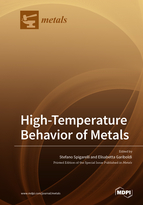High-Temperature Behavior of Metals
A special issue of Metals (ISSN 2075-4701). This special issue belongs to the section "Metal Casting, Forming and Heat Treatment".
Deadline for manuscript submissions: closed (30 April 2021) | Viewed by 32983
Special Issue Editors
Interests: creep; high-temperature deformation and hot working; steels; aluminum alloys; metal matrix composites
Special Issues, Collections and Topics in MDPI journals
Interests: high temperature mechanical behavior; creep; high temperature microstructural stability; aluminum alloys
Special Issues, Collections and Topics in MDPI journals
Special Issue Information
Dear Colleagues,
The design of new alloys or metal-based composites as well as the optimization of processes involving whichever form of high-temperature deformation cannot disregard the characterization and/or modelling of the high-temperature structural response of the material.
If this has been quite extensively investigated (but not always completely understood or described) for conventional hot working processes, there is still a lot to do to accumulate data and models and properly manage innovative deformation processes including more complex time and temperature combinations, where process-related microstructural changes can severely affect the same processability of the material as well as its final properties (structural or functional).
Similar considerations hold in the case of conventional or innovative metallic materials, where ‘high-temperature deformation’ occurs as a consequence of high-temperature service of the structural components. If extensive scientific literature is available for conventional material and for ‘conventional’ service conditions reproduced by the constant load creep test condition, there is still a lot to do in the field of alloy and processing design in view of widening the temperature and loading ranges of existing or innovative materials, including improving the characterization methods and data for material behavior under complex service conditions (i.e., stress relaxation, environmental effects and combination of repeated cycles, presence of flaws) and modelling high-temperature material behavior in all these situations, while considering the need of extended ranges of applicability of these models. The knowledge of the effects on the initial microstructure as well as the microstructural changes taking place during in-service deformation are of course of paramount importance for the optimization of high-temperature structural alloys.
The main focus on the Special Issue ‘High-Temperature Behavior of Metals” is to collect contributions dealing with a wide range of metallic materials and presenting the recent advances in the field of high-temperature structural behavior of metallic materials, which is of interest during both the manufacturing and the service stages of the components’ life and which is intimately linked to microstructural features, their evolution with deformation or exposure time, and thus other material characteristics of potential interest for specific applications.
Prof. Dr. Stefano Spigarelli
Prof. Dr. Elisabetta Gariboldi
Guest Editors
Manuscript Submission Information
Manuscripts should be submitted online at www.mdpi.com by registering and logging in to this website. Once you are registered, click here to go to the submission form. Manuscripts can be submitted until the deadline. All submissions that pass pre-check are peer-reviewed. Accepted papers will be published continuously in the journal (as soon as accepted) and will be listed together on the special issue website. Research articles, review articles as well as short communications are invited. For planned papers, a title and short abstract (about 100 words) can be sent to the Editorial Office for announcement on this website.
Submitted manuscripts should not have been published previously, nor be under consideration for publication elsewhere (except conference proceedings papers). All manuscripts are thoroughly refereed through a single-blind peer-review process. A guide for authors and other relevant information for submission of manuscripts is available on the Instructions for Authors page. Metals is an international peer-reviewed open access monthly journal published by MDPI.
Please visit the Instructions for Authors page before submitting a manuscript. The Article Processing Charge (APC) for publication in this open access journal is 2600 CHF (Swiss Francs). Submitted papers should be well formatted and use good English. Authors may use MDPI's English editing service prior to publication or during author revisions.
Keywords
- High-temperature structural behavior
- Hot working
- Creep
- Creep-fatigue
- Relaxation
- High-temperature toughness
- Microstructural stability
- Deformation-induced microstructural changes
- Deformation-induced functional property changes
- Modelling
- Alloy design







